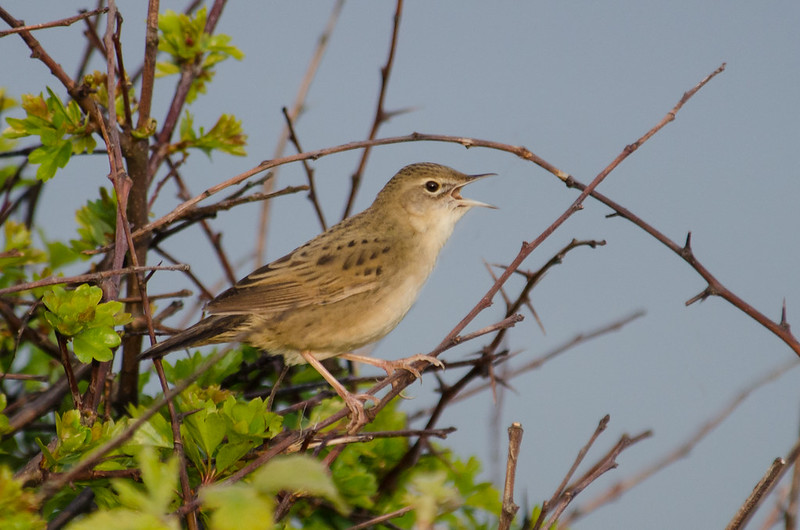
If I saw this bird perched out in the open like this, my first thought would be ‘Hmm, what’s that?’ and I’d be flicking through the possibilities in my head before quite quickly getting to the right answer. I’ve rarely seen this species as well as Tim Melling photographed this one, although I’ve heard it hundreds of times.
I’m pretty sure that the first Grasshopper Warbler that knowingly came into my life was on Brean Down, Somerset, in late April 1970 on a school birdwatching outing. There were a few Grasshopper Warblers, or Groppers, that had arrived from Africa on their spring migration and they were singing from the scrub on the sheltered side of the humpbacked point which sticks out into the Bristol Channel.
The song is easy – they sound like grasshoppers or crickets, hence the name. there are some other species with similar songs but you aren’t very likely to come across any of them in most parts of the UK so if you come across a reeling song like a grasshopper then it is either a grasshopper (or cricket) or a Grasshopper Warbler.
Here are three examples from across Europe, the first from Germany:
… and another from the Netherlands;
And this one from Cambridgeshire, UK;
They do sound like grasshoppers don’t they?
Did you hear them? I have to admit I was struggling to find recordings that I could hear. The Grasshopper Warbler is one of the species that as one ages, is likely to fall out of your list of detectable sounds (no wonder they are getting rarer!!). As are grasshoppers! Those lazy, hazy days of summer when you lay with a straw in your mouth looking at a bright blue sky and listening to Turtle Doves, Skylarks and the sound of grasshoppers in the meadow were real, and the meadows, the Turtle Doves and the Skylarks are all less numerous now, and so are the grasshoppers, but the grasshoppers are less rare than you think – you just can’t hear them as well. Well, join the club!
I knew I was missing grasshoppers about a decade ago (read about it here), and so I wondered whether I was missing Grasshopper Warblers too. But I’ve heard a few over recent years. And I always wondered how come I seemed to be able to hear recordings of them…but now it seems that I’m losing them too.
Which seems a good note, or missed note, on which to end this series of blog posts about bird song, except that there will be one more to round it off with a round number. Back soon!
[registration_form]
I heard and saw my first Grasshopper Warbler at Aketon, between Follifoot and Spofforth south of Harrogate in June 1967. I have subsequently heard and seen them at many sites since. I’ve not often seen them as well as in Tim’s photograph. However about 10 years ago I started to have difficulty hearing them and now have to be very close to the singing bird to hear it, I no longer hear, crickets, grasshoppers, goldcrests, treecreepers or calling pipits. I suspect its time I did something about it. I rather like Grasshopper Warblers and the fact that they sing with their beak so wide open.
Get yourself some NHS hearing aids. The first thing I noticed when I walked out wearing them, apart from my noisy clothes, was birdsong. How much had I missed? I had lost hearing for high frequencies (I blame The Who!). Why is there a stigma attached to hearing aids – nobody bothers about spectacles? They are virtually invisible these days. To try and manage without is sensory deprivation – the longer you leave it, the more the brain loses the processing facility.
NHS audiology is wonderful. Birdsong is wonderful too.
I think my hearing was damaged working in very noisy labs in the 80s and 90s. When I started serious birdwatching I was never able to hear groppers until I got my wonderful NHS digital hearing aids. I do hear them now but still find I need someone else to notice them first.
Is Grasshopper warbler the only European warbler with different colour morphs? There is a brown morph, which looks very dunnock-coloured and a “yellow” morph which is more olive on the upperparts and has a yellowish wash on the underparts. Juveniles and adults show the same differences. In Britain, you get both kinds in most places. I wonder what that is about?
Rhys – I’d forgotten that. Presumably this is true across their range. What is it all about? Do you know what the proportions of each colour are? And have they changed at all?
Mark
I think that Grasshopper Warbler has these two morphs everywhere in its range. I think that brown is commoner than yellow in the UK, but don’t know if it has changed. I wonder if any BTO ringers record it? I don’t think that the other Locustella species have the same dimorphism, which came as a disappointment because I had hoped that it might be an ancient dimorphism that came about before more recent speciation (like the grey/hepatic dimorphism in Cuculus cuckoos probably is). Not sure though. Careful reading of the book “Reed and Bush Warblers” by Peter Kennerley and David J. Pearson would probably resolve it, but I don’t have a copy on my bookshelf. Do you?